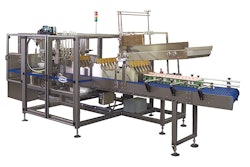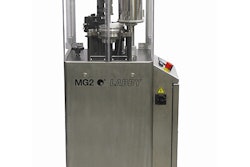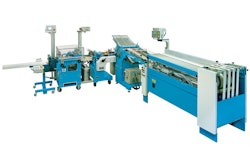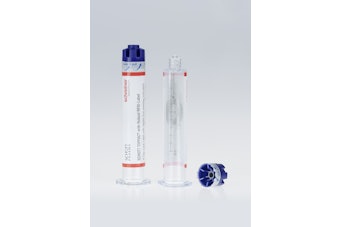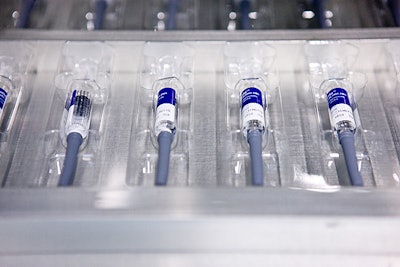
Robotics help Novartis achieve better pallet management, control of materials, reduce the risk of cross contamination, and reduce heavy manual activities.
In Rosia, a small town near Siena, in Italy's Tuscany region, vaccines for threatening illnesses—among them influenza, polio, diphtheria, tetanus, rabies, meningitis, and others—are produced and packaged by Novartis Vaccines & Diagnostics, a division of Swiss-based Novartis AG. Novartis is the fifth-largest vaccine manufacturer in the world and is the second-largest supplier of flu vaccines in the U.S.
To preserve a safe and sterile environment, everyone at the Novartis plant in Rosia has to respect Good Manufacturing Practices (GMPs). Here, up to 35 different vaccines are prepared and packaged for shipment to 70 countries around the world. The only workers who don't have to follow the GMP-mandated dress code are three hard-working robots from ABB Robotics .
The first robot to be installed at the plant was an IRB 660 FlexPalletizer™ palletizing robot in 2005. The IRB 660 is equipped with two scanners and sorts cases arriving on a conveyor belt by reading their bar codes. Depending on their contents and destination, it places them on one of three pallets for shipping. “The shapes of the boxes change significantly for different markets worldwide,” says Carlo Romani, process engineering manager for secondary technical operations.
The robot is designed to do the placement in a way that ensures maximum stability in the loading of the pallets. The palletizer has proved so fast and reliable—replacing the work of up to three employees—that it will soon be moved to a larger area where it will load six pallets at a time.
The second robot, the IRB 340 FlexPicker™ pick-and-place robot, arrived at the plant in 2006 and is used primarily in packaging oral vaccines for polio. The IRB 340's advanced vision system is an essential component of the production process because it has to pick up each polio cartridge individually from a conveyor belt and position it correctly in a box of 20 cartridges. Here, as with the palletizer, several checks for accuracy and precision are built into the process.
The most recent and most innovative robot application, according to Romani, is the IRB 260 robot denester, which became operative in March 2008. “This is a very innovative and sophisticated application, and we are the first pharmaceutical company to implement it,” he says. The IRB 260 anchors a new, 131-ft-long packaging line for flu and meningitis vaccines that handles up to 500 syringes/min and involves three separate operations, formerly done manually, which risked human error.
During operation of the packaging line, flu syringes in lidded plastic tubs arrive from the aseptic department after an inspection phase. Each tub contains a nest of 100 syringes. In the first automated operation, the robot removes the lid of each tub by vacuum. It then lifts the nest and places it on a conveyor belt. “This is a delicate step because a tub's contents may be worth thousands of euros,” says Romani.
During this process, a telecamera on the robot's head matches the contents of the tub with the tub and lid by way of datamatrix codes. This is done to ensure that there has been no cross contamination of vaccines. Three verifications are preformed, and if something is amiss, the operator is alerted.
In the final step, the empty lids and tubs are then positioned separately on a pallet for reuse. The positioning has to be precise because, in the course of a year, several million lids and tubs will be handled, and GMP for the pharmaceutical industry requires strict separation of packaging materials and products.
“This ABB robot is oversized and can handle much heavier weights than are used here, but it is perfect because of its speed and precision,” says Claudio Boncompagni, in charge of validation for Fill-Finish (packaging) Operations
As for the syringes, after being placed on the conveyor, they advance to the next station on the line for final packaging before distribution.
Notes Romani, use of the IRB 260 robot denester allows for complete control of tubs coming from the filling department, the same level of accuracy in handling for each nest of vaccines, and a reduction in safety issues close to the packaging machine.
He adds that Novartis' use of robotics has enabled the company to achieve better pallet management, additional control of materials, a drastically reduced risk of cross contamination, and a reduction in manual activities having a heavy ergonomic impact.
--By Anne Marie Mohan, Contributing Editor, Healthcare Packaging
In Rosia, a small town near Siena, in Italy's Tuscany region, vaccines for threatening illnesses—among them influenza, polio, diphtheria, tetanus, rabies, meningitis, and others—are produced and packaged by Novartis Vaccines & Diagnostics, a division of Swiss-based Novartis AG. Novartis is the fifth-largest vaccine manufacturer in the world and is the second-largest supplier of flu vaccines in the U.S.
To preserve a safe and sterile environment, everyone at the Novartis plant in Rosia has to respect Good Manufacturing Practices (GMPs). Here, up to 35 different vaccines are prepared and packaged for shipment to 70 countries around the world. The only workers who don't have to follow the GMP-mandated dress code are three hard-working robots from ABB Robotics .
The first robot to be installed at the plant was an IRB 660 FlexPalletizer™ palletizing robot in 2005. The IRB 660 is equipped with two scanners and sorts cases arriving on a conveyor belt by reading their bar codes. Depending on their contents and destination, it places them on one of three pallets for shipping. “The shapes of the boxes change significantly for different markets worldwide,” says Carlo Romani, process engineering manager for secondary technical operations.
The robot is designed to do the placement in a way that ensures maximum stability in the loading of the pallets. The palletizer has proved so fast and reliable—replacing the work of up to three employees—that it will soon be moved to a larger area where it will load six pallets at a time.
The second robot, the IRB 340 FlexPicker™ pick-and-place robot, arrived at the plant in 2006 and is used primarily in packaging oral vaccines for polio. The IRB 340's advanced vision system is an essential component of the production process because it has to pick up each polio cartridge individually from a conveyor belt and position it correctly in a box of 20 cartridges. Here, as with the palletizer, several checks for accuracy and precision are built into the process.
The most recent and most innovative robot application, according to Romani, is the IRB 260 robot denester, which became operative in March 2008. “This is a very innovative and sophisticated application, and we are the first pharmaceutical company to implement it,” he says. The IRB 260 anchors a new, 131-ft-long packaging line for flu and meningitis vaccines that handles up to 500 syringes/min and involves three separate operations, formerly done manually, which risked human error.
During operation of the packaging line, flu syringes in lidded plastic tubs arrive from the aseptic department after an inspection phase. Each tub contains a nest of 100 syringes. In the first automated operation, the robot removes the lid of each tub by vacuum. It then lifts the nest and places it on a conveyor belt. “This is a delicate step because a tub's contents may be worth thousands of euros,” says Romani.
During this process, a telecamera on the robot's head matches the contents of the tub with the tub and lid by way of datamatrix codes. This is done to ensure that there has been no cross contamination of vaccines. Three verifications are preformed, and if something is amiss, the operator is alerted.
In the final step, the empty lids and tubs are then positioned separately on a pallet for reuse. The positioning has to be precise because, in the course of a year, several million lids and tubs will be handled, and GMP for the pharmaceutical industry requires strict separation of packaging materials and products.
“This ABB robot is oversized and can handle much heavier weights than are used here, but it is perfect because of its speed and precision,” says Claudio Boncompagni, in charge of validation for Fill-Finish (packaging) Operations
As for the syringes, after being placed on the conveyor, they advance to the next station on the line for final packaging before distribution.
Notes Romani, use of the IRB 260 robot denester allows for complete control of tubs coming from the filling department, the same level of accuracy in handling for each nest of vaccines, and a reduction in safety issues close to the packaging machine.
He adds that Novartis' use of robotics has enabled the company to achieve better pallet management, additional control of materials, a drastically reduced risk of cross contamination, and a reduction in manual activities having a heavy ergonomic impact.
--By Anne Marie Mohan, Contributing Editor, Healthcare Packaging



